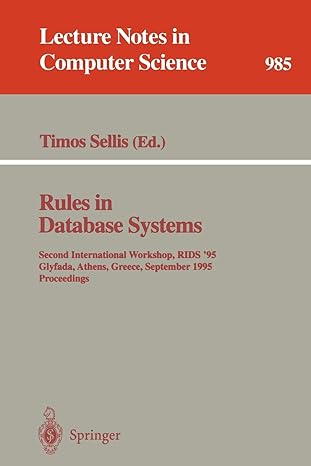Question
Please do it in java. Thanks! 1. Implement a class named StackOfObjects that can (theoretically) store an infinite number of values. This class has the
Please do it in java. Thanks!
1. Implement a class named StackOfObjects that can (theoretically) store an infinite number of values. This class has the following instance variables and methods:
* A private Object array. This array should be declared as an instance variable, but not instantiated until the constructor (described below) executes. As the array fills up, it will be replaced with a new, larger array that contains all of its previous contents.
* A private integer variable named size that counts the current number of elements stored in the array. (size 1) is the index of the element at the top of the stack.
* A public no-argument constructor that initializes the array instance variable with an initial capacity of 2. The constructor initializes size to 0; the array is initially empty.
* A public (no-argument) size() method that returns the number of stack items.
* A public push() method that takes a single Object argument and inserts it into the array at the first available index (i.e., size), incrementing size afterward. If the array is already full before you insert the new value, call expand() (described below) first to resize the internal array before performing the insertion.
* A public pop() method that does not take any arguments. This method removes the top element of the stack (meaning the item at index (size 1)) and decrements size before returning the value that was removed. You may assume that the user will never attempt to pop a value from an empty stack.
* A private helper method named expand() that takes no arguments and does not return anything. This method creates a new Object array that is twice as large as the current internal array, copies the old arrays contents into the new array, and then assigns the new (larger) array to the class instance variable (replacing the old array). This method does not modify size; the new array initially has the same contents as the old array.
Write some code (a main() method inside your class or in a separate driver class) to test your StackOfObjects class by repeatedly pushing and popping values and displaying the stack size as it changes. For simplicity, use Strings (which are objects) as your stack data.
2. Design a class named Account that contains:
* A private int data field named id (whose default value is 0).
* A private double data field named balance (whose default value is 1000).
* A private double data field named annualInterestRate (whose default value is 4.50).
* A no-arg constructor that creates a new Account object with default values. * A second constructor that creates an Account with a specified id and non-negative
initial balance (and the default interest rate).
* A third constructor that creates an Account with a specified id, non-negative initial balance, and non-negative interest rate.
* public accessor and mutator methods for all three instance variables. * A public method named getMonthlyInterestRate() that returns the monthly
interest rate (annualInterestRate/12).
* A public method named withdraw() that takes a double argument. If the account balance is smaller than that amount, print a statement saying that there are insufficient funds and leave the balance unchanged. Otherwise, deduct the argument value from the current account balance.
* A public deposit() method that adds the value of its (positive) double argument to the current account balance.
* A public toString() method that prints the values of each instance variable in an appropriate format.
Next, create a subclass of Account named CheckingAccount. A CheckingAccount has an overdraft limit (a double instance variable whose value is set by an additional constructor and a mutator method); if you attempt to withdraw more money than the account currently has, the withdrawal still succeeds as long as the total amount is less than or equal to the current balance plus the overdraft limit (the account balance just becomes negative after this). Override toString() to include the overdraft limit.
Write a test program that creates one Account and one CheckingAccount and invokes their toString() methods.
Step by Step Solution
There are 3 Steps involved in it
Step: 1

Get Instant Access to Expert-Tailored Solutions
See step-by-step solutions with expert insights and AI powered tools for academic success
Step: 2

Step: 3

Ace Your Homework with AI
Get the answers you need in no time with our AI-driven, step-by-step assistance
Get Started


